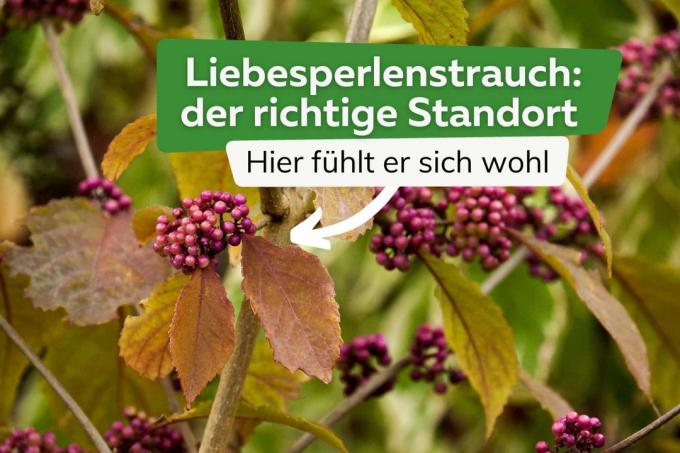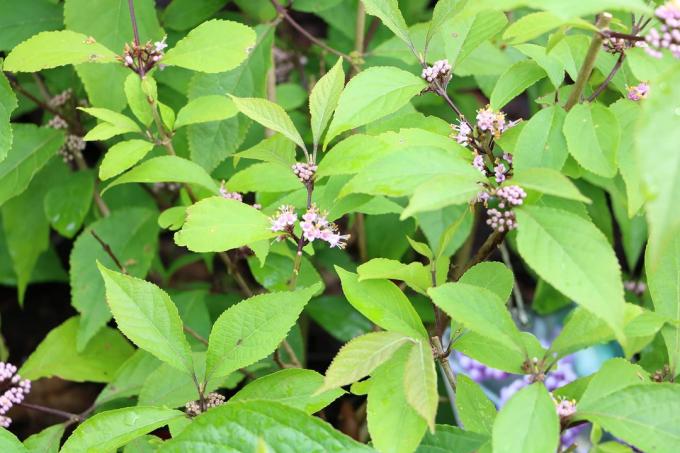
The love pearl bush or beauty fruit owes its prosaic name to the colorful fruit decoration made of violet berries. The love pearl bush, which comes from Asia, feels particularly at home in this location.
In a nutshell
- preferably sunny and sheltered from the wind, avoid draughts
- also suitable for semi-shady or sunny locations
- fresh to moist, well-drained and nutrient-rich soil
- slightly acidic to neutral pH
- Versatile, can be kept in buckets
Table of contents
- Location
- Floor
- use
- possible combinations
- Bucket attitude
- frequently asked Questions
Location
Basically, the love pearl bush (Callicarpa bodinieri) prefers a location that is as sunny and sheltered from the wind as possible, because all the more The sunnier it is, the more luxuriantly the shrub blooms between July and August and the more colorful it develops in autumn fruit decoration. However, the ornamental shrub also feels comfortable in partially shaded and sunny locations, provided it is not too windy there. Cold wind should be avoided if possible.

Tip: If you value a particularly large number of beautiful berries, you should plant several shrubs. This leads to better pollination of the flowers and thus more fruit.
Floor
In order for the love pearl bush to feel comfortable in its new location, the soil should have the following properties:
- nutritious, rich in humus
- fresh to moist
- lime free
- slightly acidic to neutral pH
- well drained

In full sun locations there is often the problem that the soil is too dry here and you therefore have to water the plants particularly often in months with little rain. Here could be one partially shaded or sunny location be the better choice because it requires less care.
Tip: The beauty fruit is not only easy to care for, but also shows itself to be resistant to many pathogens and pests in suitable locations.
use
Plant the beauty fruit
- as a solitaire
- in groups
- as a hedge
- as a path border or lawn border
- in front of a fence or wall
- or in a woody border
Tip: The love pearl bush is also suitable as a privacy screenbecause, depending on the variety, it can grow up to three meters high and up to two meters wide.
possible combinations
Plant the love pearl bush either individually, together with other specimens of the same species (possibly different varieties such as 'Profusion', 'Magical Snow Queen', 'Magical Purple Giant', 'Issai' or 'Leucocarpa') or with others ornamental shrubs. The beauty fruit harmonises particularly well with species that have bright yellow or orange leaves in autumn. These include, for example
- mock hazel
- Wreath and spring spars
- plume bush
- witch hazel
- fan maple (v. a. the variegated varieties)

Tip: When planning shrubbery borders, make absolutely sure that the planting neighbors have the same needs in terms of location, soil composition and soil moisture, and care.
Bucket attitude
In fact, the love pearl bush can be kept very well in the bucket, provided you follow these rules:
- big enough pot
- repot every two to three years in a larger container and fresh soil
- use low-lime, peaty potting soil with a slightly acidic or neutral pH value
- ideal pH: 5.5 to 6
- Mix commercially available, humus-rich potting soil with rhododendron soil
- ensure good pot drainage, avoid waterlogging
- water regularly and fertilize two to three times a year
Since the love pearl bush is one of the slow-growing shrubs, growing by around ten to 30 centimeters per year, you can initially plant it on the balcony or similar. ä. place locations. At some point, however, the ornamental tree will need a place with sufficient opportunities to spread.
Tip: If you keep them in containers, give preference to the slightly smaller varieties 'Magical Snow Queen' (white-flowering, up to 200 centimeters high) or 'Issai' (up to 250 centimeters high).
frequently asked Questions
In fact, the love pearl bush is considered slightly poisonous. The beautiful fruits in particular contain slightly toxic substances such as callicapenal, intermedeol or spathulenol, with the toxin content varying depending on the specimen and variety. Accidental consumption of berries or leaves can therefore lead to stomach upset, vomiting, nausea and/or circulatory problems.
As with other trees and shrubs, the best time to plant or transplant the love pearl bush is spring or early Autumn – the soil is often still warm until the beginning of October, allowing the plants to root in time before the first frosty days can. In spring, mild days in March or April are recommended for transplanting. Be careful to damage as few roots as possible and the shrub in the course of transplanting cut back.
The love pearl bush originally comes from central and western China, where it occurs naturally at mountainous altitudes of up to 3400 meters. Therefore, the plant is used to inhospitable temperatures and is also hardy here. Nevertheless, frost damage can occur, especially in young specimens, but damaged plants usually sprout vigorously again in spring.

